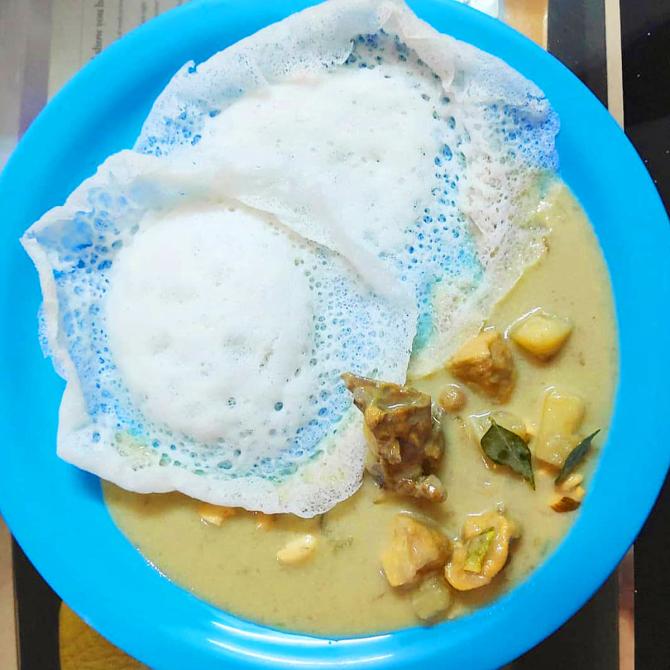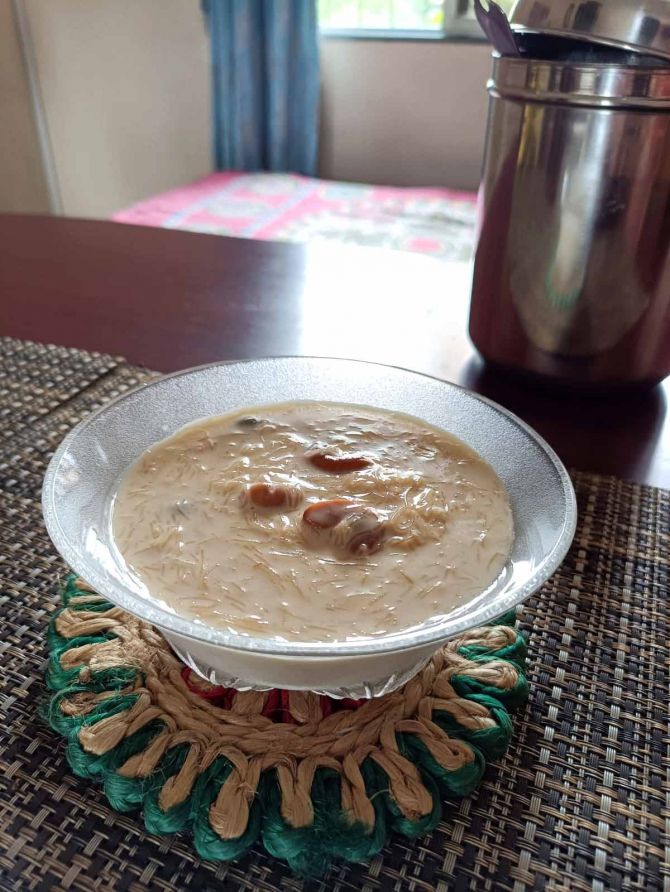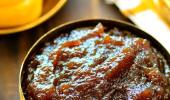Aneeshya Sreejesh keenly awaits her husband P R Sreejesh's return from the Paris Olympics, so she can celebrate his homecoming by lovingly welcoming India's hockey legend with a typical Kerala sadya or grand meal, that will include all his favourite dishes.

Festivities began in Sreejesh's home in Kizhakkambalam in Kerala's Ernakulam district the moment Team India bagged the bronze medal in Paris. Celebrations in India always means food and sweetmeats. Bright yellow Kerala laddoos were offered to all the neighbours who came over to toast the win.
Aneeshya, a former long jumper, Ayurveda doctor and mum of two, is already planning the feast for her 'Sree', that she says will be "traditional Kerala food, vegetarian and non-vegetarian" because "he loves it so much" and she's certain after days of unspicy, rather insipid, French fare he is looking forward her cooking.

Photograph: Kind courtesy PR Sreejesh/Instagram
But what is a traditional Kerala meal?
Given the number of incredible classical dishes made in homes across Kerala, it's hard to guess what this doting wife plans to rustle up in her kitchen.
Malayalees tend to stick to the basics and our food is very rooted in tradition, which means Aneeshya is likely cooking up some old-fashioned favourites for her hubby.
Maybe she is thinking of pidi, a fantastic breakfast that will keep you full until lunch and is something a family enjoys eating together. These marble-sized steamed rice balls are paired with kozhi (chicken) curry. The pungent gravy and the spiced rice dumplings make for an excellent pairing.

The soft, fluffy, thattu dosa uses parboiled rice and is thicker than the average dosa -- it's another super choice for breakfast or brunch. It can be had with regular coconut chutney, made with red chillies, a tadka of rai, Kerala's beloved cheriya ulli (shallots) and curry leaves.
This dosa is a best-selling item at every thattu kada (roadside stall) and will surely win Sreejesh over the minute he gets home. Thattu dosa goes well with a thengai chammanthi. The ingredients of this dry, coarse mixture are fresh coconut, shallots, curry leaves, coconut oil, ginger.

When jackfruit is in season -- nowadays it is available 24/7 as it is cut, dried and stored in air-tight bags for a year -- many opt for the wholesome chakka vevichathu or boiled jackfruit, tempered with mustard seeds and curry leaves, fried in coconut oil and cooked with coconut.
Kappa, or tapioca, is prepared in a similar manner and the poor man's food Kappa Puzhukku is a great substitute to the fermented rice staple, dosa.
But whether you choose a breakfast made with rice, kappa or chakka, every meal in a Malayalee household ends with ripe njali poovan pazhan(elaichi banana). And people can't settle for just one! There is Pazham Pori too. Crispy on the outside, soft on the inside, these nendra pazham fritters taste divine.

Ever tried crushing a papadum and having it with mashed bananas? It's an utterly delicious. And it comes to the rescue every time dessert is missing from the dining table.
Puttu is generally served with ripe elaichi banana or with sugar and crushed fried papadum soups it up brilliantly as well. But nothing compares to the joy of having puttu with fish or kadala curry. Puttu and leftover kozhi or mutta (egg) curry is a winning combo too.
Kanji, chamandi podi and papadum together is as simple and traditional as a Kerala meal can get. So is rice, meen (fish) curry, fish fry and kadumanga (mango pickle) or else lemon pickle.

There are a dozen ways to enjoy a fish curry. Yet kappa and meen are a match made in heaven. Boiled and mashed tapioca, cooked with coconut, is the perfect side with the super-spicy gravy.
It is best eaten using your hands and mixing the kappa well with the curry so that every bite is an explosion of flavours.

Pothichor mustn't be missed when it comes to local, authentic food. It's a parcel of goodness. Rice, curry, cooked vegetables and pickle are wrapped in a plantain leaf and served.

Non-vegetarians add a fried fish to their pothichors, and this dish reminds you of home. It also brings back wonderful childhood memories of travelling with the parents by train to Kerala to visit the grandparents.
Every journey home to Mumbai was accompanied by packets of pothichor for lunch/dinner with oodles of ummas (kisses) from teary-eyed relatives.

There is more to a South Indian-style breakfast than idli, dosa, uttappam and appam. Iddiyappam or noolappam is basically rice noodles with a generous filling of coconut and jaggery.
It can be dined on alone or with chicken/fish curry for lunch/dinner. At breakfast it is served along with a bowl of warm sweetened milk.

No mention of Kerala food is complete without remembering the appam. You will find several types -- noolappam or iddiyappam, palappam, vattayappam, unniyappam and achappam.
It is said that Arab traders introduced biryani to the Malabar coast. One of Kerala's popular dishes, the Chicken Biryani never ever disappoints. A sure-shot way to make it more impressive is to add a whole boiled egg, garnish it with crispy fried onions and raisins, sauteed in ghee and serve up with a good raita. It is a dish that Sreejesh loves and is an ideal meal by itself.
A traditional vegetarian Kerala-style meal will include choru (boiled rice), sambar, rasam, papadum, mango and lime pickle, along with a thoran (sabji).
During Onam, the spread gets much more elaborate and the exceptional fare features nendran or banana chips, inji puli (tamarind-ginger pickle), avial, olan, pachadi, eriserry, kootu, curry and kaalan.
It's not really a red-letter occasion without dessert, and the best Mallu meals always end on a high note with payasam or kheer.
In Kerala you'll be spoilt for choice deciding between Semiya Payasam, also known as Vermicelli Payasam, Ada Pradhaman, Parippu Payasam, Palada Payasam and the much-loved Gothambu Pradhaman.
We bet Aneeshya's conjuring up a potful of payasam for Sreejesh that will taste out of this world! Cheers, Sreejesh.

Additional inputs: PTI











